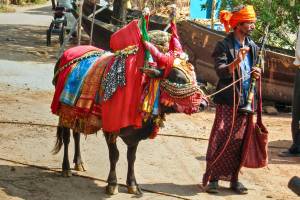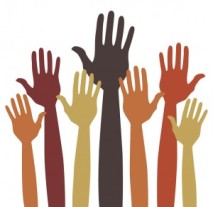
The other day, I walked into my 12-month old daughter’s doctor’s appointment and was thrilled to be handed a children’s book! My daughter also enthusiastically started pointing and saying “boo” “boo”! Before my pediatrician needed to do her spiel on why books are so important for babies, I told her about my daughter’s frequent visits to our “reading center.” My daughter loves going to a special place in our house to point out books that she wants read to her. Her favorite books right now are “peek-a-boo” and “nursery rhyme” books.
Since my son was born, we have had a “reading center” in every apartment, town home, or home we have lived in. My son was born in a one-bedroom apartment in New York—-yet, even there I was able to carve out a nook (or rather a cranny!) for reading. Currently, we live in the suburbs and are afforded more space for reading. Our reading center is in the corner of our living room and features a comfy, big Costco bear, a beanbag, pillows, blankets, and cases of age-appropriate books. I love being able to say “book” to my daughter and watch her crawl over to her space.
Recently, the American Academy of Pediatrics (AAP) announced the importance of reading to babies. As an educator, I have known about the importance of reading to babies for brain development, and more specifically, for oral language development and early literacy skills. However, I realize that not every parent has the knowledge, time or resources to read to their child. Many articles point to socio-economic class being the differentiating factor between whether or not children are read to from a young age. Unfortunately, the research shows that children from high socio-economic families know 30 million more words than children from low socio-economic families by the age of three.
It is interesting to note that while the majority of this word gap can be attributed to socio-economic class, I also believe that culture influences whether or not a child is a read to at home. From my experiences, it wasn’t class but culture that dictated whether reading was prioritized in my family. Growing up, I don’t recall my parents reading children’s books with me and discusses the motivations of the main character in the book. Rather, we had “math time” where my father and I would sit down to work out math problems together. Researchers have found that many Asian American families prioritize math because there is always a right answer. First generation immigrant parents feel that their children will naturally learn English because they live in a English-speaking country and are exposed to it everyday. As a result of prioritizing math and the sciences, the research has found that many Asian American children struggle with oral language skills. Many Asian Americans pursue careers in the math and the sciences, because they don’t have the confidence that they need to excel in other subject areas. I believe this discussion on reading to babies needs to address the “knowledge gap” when it comes to making sure all cultural groups are aware of the importance of reading (and talking) to infants and children.
Furthermore, while the AAP recommends reading books to children, hybrid parents want to know what types of books they should be reading to children that allow for them to meet the cognitive, social, emotional, linguistic and cultural needs of their children. For hybrid parents, the discussion of reading to infants needs to address what their infants are being exposed to and what they are not being exposed to. It’s not just about the quantity of books that we read to our children but about the quality of books.
In my Child and Adolescent Development courses at San Jose State, we discuss how to meet the developmental needs of infants. Infants typically develop object permanence by six months of age. Object permanence is this idea that objects are permanent and even when a object cannot be seen, it is still there. When something is hidden, infants know it still exists and that excites them—-because just a month ago they thought that object was gone forever. You also want to make sure you have books that are related to sensory development. Infants love books that engage their five senses. Things they can see, touch, taste, smell, and hear such as Pat the Bunny.
Infants also use social referencing to make sense of the world. What this means is that they will look to you when they are trying to make sense of a new situation. If they are meeting Grandma for the first time, your reaction will help them figure out if this is someone they can trust. If they fall for the first time, your positive or negative reaction will cue them into how they should respond about falling.
Books can also help infants make sense of their diverse world. Books can expose infants to people of different races or ethnicities as well as cultural experiences that they may not encounter until later in life. Research shows that infants will look longer at an unfamiliar face (such as someone who is from a different race) than someone from the same race as them (Katz and Kofkin, 1997). With more diverse books (#colormyshelf), infants can start to become more familiar with the diverse world that we live in.
Top 10 Categories of Books for Infants Cognitive, Social, Emotional, Linguistic and Cultural Needs
- Sound books (e.g., Moo, Zoom) – develops early literacy skills, children learn to play with sounds and differentiate sounds before identifying them visually (i.e.phonemic awareness)
- Alphabet books – develops early literacy skills, children learn to visually identify letters (i.e. phonics)
- Bilingual books (e.g., body parts, colors) – develops bilingual skills; bilingualism gives children social, linguistic, and cognitive advantages in life
- Nursery Rhyme books (e.g., wheels on the bus)- develops oral language skills, engages infants through hand gestures and finger plays
- Peek-a-Boo Books– reinforces object permanence; infants love repetition and mastering the skill of playing peek-a-boo with books and people!
- Touch & Feel Sensory Books– reinforces sensory development; infants make sense of the world through their senses
- Routine books (e.g.,good night routines)– reinforces routines for babies; infants like predictable routines to make sense of their ever-changing world; it provides them with comfort and a sense of belonging
- Pro-social Books (e.g., saying hello, please, sharing) – develops social skills; provides infants/toddlers with an understanding of how to greet friends and use their manners with simple words and gestures
- Feelings/Emotions (e.g., happy, sad) – promotes emotional skills; provides infants/toddlers with visuals to identify and recognize feelings (also good for transitions to toddlerhood and managing tantrums)
- Multicultural Books – develops social skills and an awareness of others; helps infants/toddlers make sense of their diverse world by exposing them to various races, ethnicities, and cultures
References
Katz, P. A., & Kofkin, J. A. (1997). Race, gender, and young children. In S. S. Luthar & J. A. Burack (Eds.), Developmental psychopathology: Perspectives on adjustment, risk, and disorder (pp. 51–74). New York, NY: Cambridge University Press.









